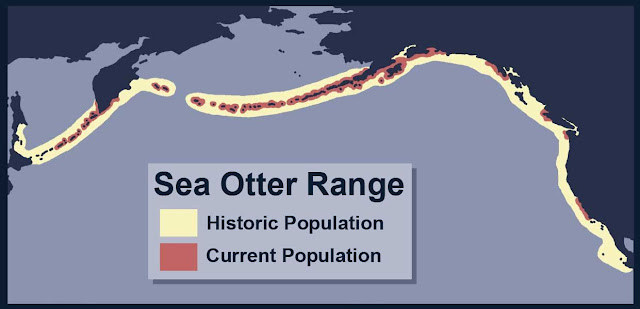 |
| Source: wvoutpost.com |
 |
| Produced by Simone Barker one of two figures produced by Simone Barker |
Once implemented the North Pacific Fur Seal Treaty led to the recovery of the population. The population was recovered from 11 sub-populations that were far dispersed and isolated. Each sub-population grew, repopulating its area. Due to the isolation of these populations they weren't able to interbreed, resulting each having low genetic diversity (IUNC Red List). In small isolated populations you only have the diversity of the individuals in your community, and the fewer members you have the less diverse your population is. Genetic diversity is extremely important for the survival of a population. It provides the differences that allow some members of the population an adaptive edge; when they are affected by things like invasive species, pathogens, or climate change. The individuals that possess adaptive difference would be able to survive these events allowing the species to continue to exist (Groom, chapter 11). During this recovery the Southern sea otter (which lives along California coast) was protected under the Endangered Species Act starting in 1977, where it was listed as threatened (U.S. Fish and Wildlife Service). Since the 1980s there have been many efforts to help recover sea otter population including management and different governmental protection. Even with these efforts sea otter populations continue to be fairly small, this is in part due to the current threats: oil spills, pathogens, predation and possible other reasons that are currently unknown (IUNC Red List).
Sources:
1. "The Otter Project." The
Otter Project. N.p., n.d. Web. 23 Feb. 2013.
<http://www.otterproject.org/about-sea-otters/natural-history/>.
2. "North Pacific
Fur Seal Treaty of 1911." NOAA 200th Top Tens: Historical
Events:.NOAA, 19 July 2012. Web. 23 Feb. 2013.
<http://celebrating200years.noaa.gov/events/fursealtreaty/welcome.html>.
3. "Enhydra Lutris." (Sea Otter). N.p., n.d. Web. 24 Feb. 2013.
<http://www.iucnredlist.org/details/7750/0>.
4. Ventura Fish and Wildlife Office." U.S. Fish and Wildlife Service. N.p., 10 Mar. 2013. Web.
10 Mar. 2013.<http://www.fws.gov/ventura/species_information/so_sea_otter/>
5.Groom, Martha J., C. Ronald Carroll, and Gary K. Meffe. "Chapter 11: Conservation
4. Ventura Fish and Wildlife Office." U.S. Fish and Wildlife Service. N.p., 10 Mar. 2013. Web.
10 Mar. 2013.<http://www.fws.gov/ventura/species_information/so_sea_otter/>
5.Groom, Martha J., C. Ronald Carroll, and Gary K. Meffe. "Chapter 11: Conservation
Genetics." Principles
of Conservation Biology. Sunderland [Mass.:
Sinauer Associates, 2006.
375-404. Print.

No comments:
Post a Comment